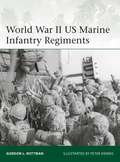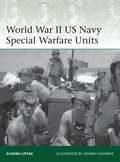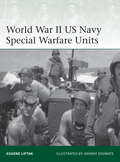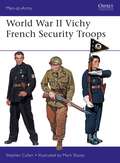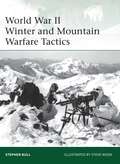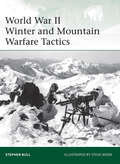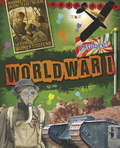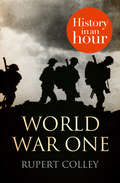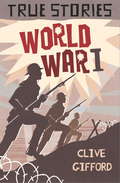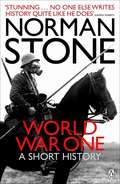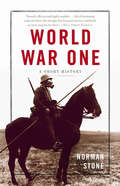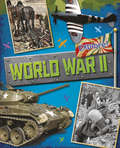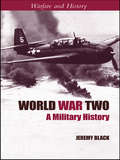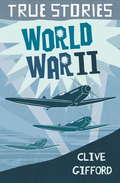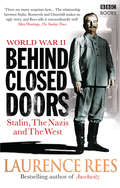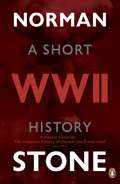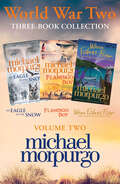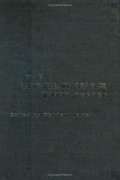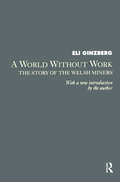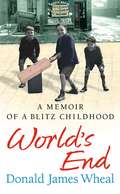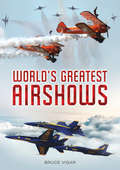- Table View
- List View
World War II US Marine Infantry Regiments (Elite #222)
by Peter Dennis Gordon L. RottmanThe United States Marine Corps came into its own in the Pacific Islands campaign against Japan in World War II. From Guadalcanal to Okinawa, US Marines formed the tip of the spear as Allied forces sought to push the Japanese back to their Home Islands.This fascinating study tracks the deployments of the various Marine divisions throughout the war and explains their composition, but also goes deeper, to detail the individual regiments – the focus of the marines' identity and pride. It explains the organization of the Marine infantry regiment and its equipment, and how they evolved during the war. The marine infantryman's evolving uniforms, field equipment and weapons are illustrated throughout using specially commissioned artwork and detailed descriptions to produce a fitting portrait of the US military's elite fighting force in the Pacific.
World War II US Navy Special Warfare Units (Elite)
by Johnny Shumate Eugene LiptakWith the need for large-scale amphibious landings to decide the outcome of World War II the US Navy developed several types of specialized unit to reconnoitre potential landing areas, degrade the enemy's ability to resist, and assist the landing forces on to the beaches. The Scouts and Raiders were the forerunners of the SEALs, Beach Jumpers made elaborate simulated landings to distract the enemy, the Naval Combat Demolition Units and Underwater Demolition Teams cleared obstacles to amphibious landings and Naval Group China fought alongside Chinese guerrillas behind Japanese lines. This book uncovers the fascinating history of these units, the unique gear they went into theatre with and the vital roles they carried out throughout the war.
World War II US Navy Special Warfare Units (Elite #203)
by Johnny Shumate Eugene LiptakWith the need for large-scale amphibious landings to decide the outcome of World War II the US Navy developed several types of specialized unit to reconnoitre potential landing areas, degrade the enemy's ability to resist, and assist the landing forces on to the beaches. The Scouts and Raiders were the forerunners of the SEALs, Beach Jumpers made elaborate simulated landings to distract the enemy, the Naval Combat Demolition Units and Underwater Demolition Teams cleared obstacles to amphibious landings and Naval Group China fought alongside Chinese guerrillas behind Japanese lines. This book uncovers the fascinating history of these units, the unique gear they went into theatre with and the vital roles they carried out throughout the war.
World War II Vichy French Security Troops (Men-at-Arms #516)
by Mark Stacey Stephen M. CullenAfter the Fall of France in 1940, a new puppet state was set up in the south. Officially known as the French State, it is better known as Vichy France. This collaborationist Vichy regime's armed forces were more active and usually more numerous than German troops in the task of hunting down and crushing the maquis - the French Resistance guerrilla forces This book will cover the organization and operations of Vichy French Security Forces, including: the new Vichy Police Nationale, particularly their Groupes Mobiles de Reserve, the Service d'Ordre Légionnaire , and the Milice Francaise, a ruthless anti-Resistance militia armed partly with British weapons captured from SOE airdrops. Fully illustrated throughout with contemporary photographs and commissioned artwork, it tells the story of Occupied France from the perspective of those who sought to keep it in German hands.
World War II Vichy French Security Troops (Men-at-Arms #516)
by Mr Mark Stacey Dr Stephen M. CullenAfter the Fall of France in 1940, a new puppet state was set up in the south. Officially known as the French State, it is better known as Vichy France. This collaborationist Vichy regime's armed forces were more active and usually more numerous than German troops in the task of hunting down and crushing the maquis - the French Resistance guerrilla forces This book will cover the organization and operations of Vichy French Security Forces, including: the new Vichy Police Nationale, particularly their Groupes Mobiles de Reserve, the Service d'Ordre Légionnaire , and the Milice Francaise, a ruthless anti-Resistance militia armed partly with British weapons captured from SOE airdrops. Fully illustrated throughout with contemporary photographs and commissioned artwork, it tells the story of Occupied France from the perspective of those who sought to keep it in German hands.
World War II Winter and Mountain Warfare Tactics (Elite)
by Steve Noon Stephen BullThe twentieth century saw an unprecedented emphasis on fighting in all terrains, seasons and weather conditions. Such conditions made even basic survival difficult as subzero temperatures caused weapons to jam, engines to seize up and soldiers to suffer frostbite, snow blindness and hypothermia. The conditions often favoured small groups of mobile, lightly armed soldiers, rather than the armoured forces or air power that dominated other combat environments. Some European armies developed small numbers of specialist alpine troops before and during World War I, but these proved to be insufficient as nearly all the major combatants of World War II found themselves fighting for extended periods in extremely hostile cold-weather and/or alpine environments. Drawing upon manuals, memoirs and unit histories and illustrated with period tactical diagrams and specially commissioned full-colour artwork, this study sheds new light on the winter-warfare tactics and techniques of the US, British, German, Soviet and Finnish armies of World War II.
World War II Winter and Mountain Warfare Tactics (Elite Ser. #193)
by Steve Noon Stephen BullThe twentieth century saw an unprecedented emphasis on fighting in all terrains, seasons and weather conditions. Such conditions made even basic survival difficult as subzero temperatures caused weapons to jam, engines to seize up and soldiers to suffer frostbite, snow blindness and hypothermia. The conditions often favoured small groups of mobile, lightly armed soldiers, rather than the armoured forces or air power that dominated other combat environments. Some European armies developed small numbers of specialist alpine troops before and during World War I, but these proved to be insufficient as nearly all the major combatants of World War II found themselves fighting for extended periods in extremely hostile cold-weather and/or alpine environments. Drawing upon manuals, memoirs and unit histories and illustrated with period tactical diagrams and specially commissioned full-colour artwork, this study sheds new light on the winter-warfare tactics and techniques of the US, British, German, Soviet and Finnish armies of World War II.
World War One: World War One (Explore! #8)
by Jane BinghamThis photographic book gives you an overview of World War One. From how the war began to how it spread worldwide, the new technology that was used in war for the first time, how women's roles changed in society because of the war, what life was like on the home front and how people recorded the war in paintings, poems and diaries. You can also find out how to send a message in Morse code.
World War One: History In An Hour (History In An Hour Ser.)
by Rupert ColleyLove history? Know your stuff with History in an Hour.
World War One: True Stories (True Stories)
by Clive GiffordThe book contains nine short stories dealing with different aspects of life during World War I.World War I includes the stories of flying aces such as the 'Red Baron', the story of Lawrence of Arabia and the stories of brave doctors and nurses such as Edith Cavell in German occupied Belgium.Complete with glossary, further reading section and index.
World War One: A Short History
by Norman StoneThe First World War was the overwhelming disaster from which everything else in the twentieth century stemmed. Fourteen million combatants died, a further twenty million were wounded, four empires were destroyed and even the victors' empires were fatally damaged. The sheer complexity and scale of the war have encouraged historians to write books on a similar scale. But now Norman Stone, one of Britain's greatest historians, has achieved the almost impossible task of writing a terse, brilliantly written, opinionated and witty short history of the conflict. In only 140 pages he distils a lifetime of teaching, arguing and thinking into what will be one of the most talked about history books of years to come.
World War One: A Short History
by Norman StoneThe First World War was the overwhelming disaster from which everything else in the twentieth century stemmed. Fourteen million combatants died, four empires were destroyed, and even the victors' empires were fatally damaged. World War I took humanity from the nineteenth century forcibly into the twentieth-and then, at Versailles, cast Europe on the path to World War II as well. In World War One, Norman Stone, one of the world's greatest historians, has achieved the almost impossible task of writing a terse and witty short history of the war. A captivating, brisk narrative, World War One is Stone's masterful effort to make sense of one of the twentieth century's pivotal conflicts.
World War One Collection: Private Peaceful, A Medal for Leroy, Farm Boy
by Michael MorpurgoThree outstanding novels by the nation’s favourite storyteller that depict unforgettable experiences of WWI.
World War Two: World War Two (Explore! #9)
by Jane BinghamThis photographic book gives you an overview of World War Two. From how the war began to how it spread worldwide, the new technology that was used in war for the first time, how women's roles changed in society because of the war, what life was like on the home front, and how the war was recorded in pictures, diaries, poems and stories. You can learn about key figures, such as Winston Churchill, and events, such as The Holocaust. You can also read a diary entry from the Blitz and learn how to create your own secret code.
World War Two: A Military History (Warfare and History)
by Jeremy BlackCutting through over half a century of historical build-up, this new and convincing account of World War II uses a global perspective to explain the complicated course in military terms. Black, a distinguished military historian , bucks the current trend to demilitarise and gives due weight to the campaigns and battles that made up the war. In doing so he challenges common interpretations and includes new insights to make this one of the most exciting new histories of the Second World War. Covering all the main areas of conflict, the chronological approach includes analysis of attacks at land, air and sea and a comparison of military resources. The focus is always operational, but social, cultural and political aspects are also included. Providing a crucial counterweight to previous histories, Jeremy Black's World War Two offers fresh insights into operations at the Eastern Front and during the war against Japan.
World War Two: A Military History (Warfare and History)
by Jeremy BlackCutting through over half a century of historical build-up, this new and convincing account of World War II uses a global perspective to explain the complicated course in military terms. Black, a distinguished military historian , bucks the current trend to demilitarise and gives due weight to the campaigns and battles that made up the war. In doing so he challenges common interpretations and includes new insights to make this one of the most exciting new histories of the Second World War. Covering all the main areas of conflict, the chronological approach includes analysis of attacks at land, air and sea and a comparison of military resources. The focus is always operational, but social, cultural and political aspects are also included. Providing a crucial counterweight to previous histories, Jeremy Black's World War Two offers fresh insights into operations at the Eastern Front and during the war against Japan.
World War Two (True Stories)
by Clive GiffordThe book contains nine short stories dealing with different aspects of life during World War II.Included is the remarkable survival story of future US President J F Kennedy, the story of the dambusters and a plotted assassination attempt on Hitler.Complete with glossary, further reading section and index.
World War Two: Stalin, the Nazis and the West
by Laurence ReesWhen do you think the Second World War ended?If the end of the war was supposed to have brought 'freedom' to countries that suffered under Nazi occupation, then for millions it did not really end until the fall of Communism. In the summer of 1945 many of the countries in Eastern Europe simply swapped the rule of one tyrant, Adolf Hitler, for that of another: Joseph Stalin. Why this happened has remained one of the most troubling questions of the entire conflict, and is at the heart of Laurence Rees' dramatic book.In World War II: Behind Closed Doors, Rees provides an intimate 'behind the scenes' history of the West's dealings with Joseph Stalin - an account which uses material only available since the opening of archives in the East as well as new testimony from witnesses from the period. An enthralling mix of high politics and the often heart-rending personal experiences of those on the ground, it will make you rethink what you believe about World War II.
World War Two: A Short History
by Norman StoneA pacy, compelling and penetrating account from Wolfson Prize-winning author Norman Stone, that shows World War Two in a fresh new lightThe Second World War is the nightmare that sits at the heart of the modern era - a total refutation of any notion of human progress and a conflict which still haunts us seventy years on.Norman Stone's gripping new book aims to tell the narrative of the war in as brief a compass as possible, making a sometimes familiar story utterly fresh and arresting. As with his highly acclaimed World War One: A Short History, there is a compelling sense of a terrible story unfolding, of a sceptical and humorous intelligence at work, and a wish to convey to an audience who may well have no memory of the conflict just how high the stakes were.This is a beautifully written, clever and imaginative attempt to convey what can almost not be conveyed. About the author:Norman Stone is one of Britain's greatest historians. His major works include The Eastern Front, 1914-1917 (winner of the Wolfson Prize and published by Penguin), Europe Transformed and The Atlantic and Its Enemies (published by Penguin). He has taught at the universities of Cambridge, Oxford and Bilkent, where he is now Director of the Turkish-Russian Centre. He lives in Ankara.Reviews:'Professor Norman Stone has achieved the impossible; he has somehow written a comprehensive history of the Second World War in just under 200 pages, summarising the entire conflict while leaving out nothing of importance and bringing his lifetime of study of the subject to bear in a witty, incisive and immensely readable way ... Norman Stone has proved yet again that he is one of the most original, witty and powerful British historians writing today' Andrew Roberts, Standpoint'The joy and strength of this compact history, besides its trenchancy and, in the publishers' words, the "sceptical and humorous intelligence at work", is its narrative clarity ... a book to clear the mind after the grand tour of the big volumes' Allan Mallinson, The Times'Novices will receive a painless introduction, but educated readers should not pass up the highly opinionated prologue and epilogue and the author's trademark acerbic commentary throughout ... Readers of all stripes ... will find plenty to ponder' Kirkus Reviews
World War Two Collection: An Eagle In The Snow, Flamingo Boy, When Fishes Flew
by Michael MorpurgoAn ebook collection of three of master storyteller Michael Morpurgo’s Second World War novels.
The World War Two Reader (Routledge Readers In History Ser.)
by Gordon MartelFrom highly respected field academic Gordon Martel, The World War Two Reader is a rare work that provides a complete and up-to-date overview of the recent historiography on World War Two. Huge in scope, both geographically and thematically, this excellent reader examines twenty-one articles by some of the best known and most innovative scholars in the field. Taking a global approach, Martel discusses all aspects of the war including: the military aspect the political and strategic backdrop ideology gender and women’s roles the home front social aspects. Including a comprehensive introduction, chronology, guides to key terms and figures, and introductions to chapters providing context and historiographical background, The World War Two Reader provides wide ranging and innovative reading for all students of the history of the modern world.
A World Without Work: Story of the Welsh Miners
by Eli GinzbergWritten just before the beginning of World War II, this is an early example of field research into human resources by one of the pioneers in the area. Ginzberg investigates why so many long-term unemployed coal miners in South Wales remained in their villages rather than relocating to other areas of the United Kingdom where jobs were more plentiful. The results of his work, originally published in 1942, remain of value both as a record of an era, an example of communities in distress, and a model of failed social policy.
A World Without Work: Story of the Welsh Miners
by Eli GinzbergWritten just before the beginning of World War II, this is an early example of field research into human resources by one of the pioneers in the area. Ginzberg investigates why so many long-term unemployed coal miners in South Wales remained in their villages rather than relocating to other areas of the United Kingdom where jobs were more plentiful. The results of his work, originally published in 1942, remain of value both as a record of an era, an example of communities in distress, and a model of failed social policy.
World's End: A Memoir Of A Blitz Childhood
by Donald JamesWorld's End is the story of Donald Wheal¹s childhood in Chelsea's World's End at the height of the Second World War.Not for him the privileged bohemian world of Chelsea a few hundred yards away. Descended from rural immigrants, ladies of the night and bare-knuckle fighters, Donald Wheal¹s upbringing took place amidst grimy factories and generating plants, illegal street bookmakers, dog tracks, tenements and street walkers who plied their trade in Piccadilly and Soho. World's End is the story of how he and his family struggled free from this underclass. It is also an individual history of the Second World War, of a small boy¹s grappling with the bitter separation of evacuation, the return to an already battered London, the wonderland of bomb-damaged houses to play in, and the nights of terror as the Blitz returned.
World's Greatest Airshows
by Bruce VigarAir shows are one of the world’s most popular, non - sporting outdoor attractions. Although the story of flight is over 100 years old, aircraft still hold a fascination for young and old, men and women from all backgrounds. Indeed, the first air show was held when aircraft and aviation was still in its infancy in the 1900s. Since then aviation has progressed in the full glare of the public gaze.Some air shows are held as a business venture or as a trade event where aircraft, avionics and other services are promoted to potential customers. Many air shows are held in support of local, national or military charities. Military air services often organise air shows at military airfields as a public relations exercise to thank the local community, promote military careers and raise the profile of the military. In this book, we cover the different types of air show and more importantly, the displays that make air shows memorable. For some it is the noise and speed of the latest military jets, for others, extraordinary aerobatics that seem to defy the laws of physics. There are also the displays of classic aircraft and warbirds as well as dramatic reconstructions of how aircraft are deployed. What is clear is how far aviation has come but questions persist in how much farther it can go?
